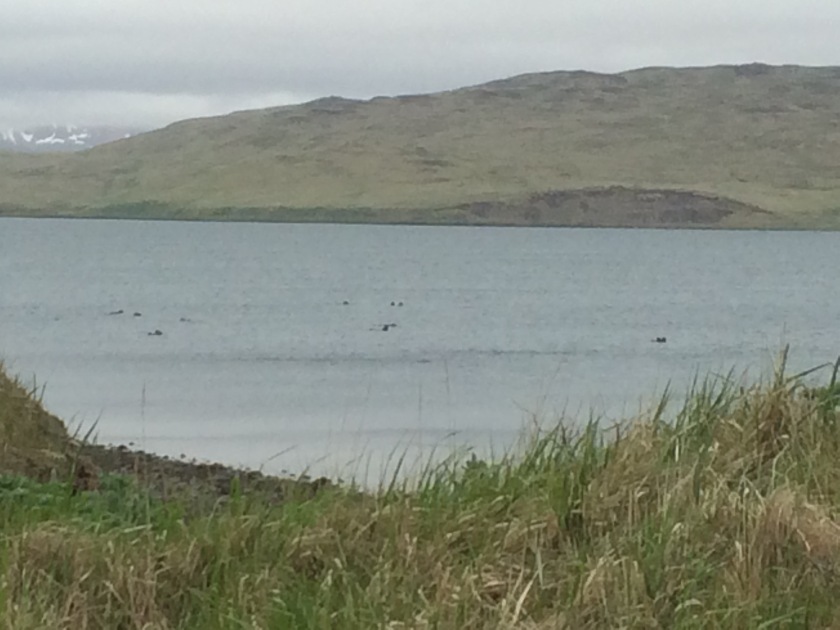Buttercups, stonecrop, and wild daisies

Aleutian plants are generally small, unlike the monster-sized devil’s club and thimbleberries that festoon Alaska’s Inside Passage. The Aleutian Islands are at latitudes mostly south of the Inside Passage, so they should be warmer, and the plants should be larger, right? But they’re not. Both parts of Alaska have a maritime ecology, but the Aleutian Islands are far more exposed, mostly to wind but also to constant cold. Although they have no permafrost, they are covered in tundra, so there are a lot of peat bogs and dwarf plant communities. The islands have what ecologists might term “low energy systems.” But there is nothing low energy about the abundance of flowers that are now blooming on Adak Island. Each time I see a new species, I figure out what it is and fall in love with it.

There are many species in common between Adak and Amchitka Islands, so getting acquainted with the local wildflowers will help me with my botanical work on Amchitka. Back home in Colorado, I am somewhat notorious for interrupting hikes in favor of “botanizing.” Things are no different here in Alaska! My botanizing adventures result in a lot of notes and photographs, and among my favorites are those of the the full grown arctic willows. They are elegant, twisted little dwarfs, decades old but only inches tall.
Along numerous trails on Adak Island, the crowberry is in bloom. I have always wanted to see crowberry, as it’s mentioned in what is still my favorite television program, Northern Exposure. There will be no berries on these plants for months yet, so I can’t try one, but there is an abundance of other wild foods on Adak Island in the early summer.

On a hike to Lake Betty, we find fiddleheads, which are the curled, emerging leaves of the ostrich fern. Craig, Danika, and I nibble a few raw, then I pick a small handful to cook later. They are marvelous, much like the variety of fiddlehead I grew up with in Maine. I also know that all violet flowers are edible, so I nibble on a couple of those as well. They are mild and sweet, and a tiny bit flowery. I wish I could meet a member of the Unangan people who would be willing to show me what else I might be able to sample.

Edible plants are not the only reason I would love to become acquainted with the Unangan. Their ancestors are believed to have lived on these islands for at least the last 2,000 but possibly up to 9,000 years. The Aleutian Islands, and the wild seas that surround them, are among the most formidable places on earth. I have a lot of respect for people who have lived here for so long and who continue to persist in spite of the adversity and atrocities brought to their home since long before the 1940s. They are certainly among the hardiest and most capable of people, with a history and culture that I would love to know more about.

Among the biota samples collected for monitoring by the first Amchitka team last month are the traditional Unangan foods of reindeer moss, chitons, and Dolly Varden. Reindeer moss is a type of gray-white lichen, which I am reluctant to taste raw but don’t know how to cook. Chitons are dark, prehistoric-looking sea creatures. I find one on the beach and pick it up, only to have it curl up slowly on my glove like a pillbug. Obviously it’s still alive, so I toss it back into the sea, wondering what something like  that could possibly taste like. Dolly Varden is a native species of trout. I dined on a lot of trout as a young person in Colorado and usually feel like I’ve had enough of it, but Craig, who wielded a fishing-license, caught an extra (the others went into a sample bag as background samples for the monitoring). It was a delicious, firm fish that I would gladly eat again.
that could possibly taste like. Dolly Varden is a native species of trout. I dined on a lot of trout as a young person in Colorado and usually feel like I’ve had enough of it, but Craig, who wielded a fishing-license, caught an extra (the others went into a sample bag as background samples for the monitoring). It was a delicious, firm fish that I would gladly eat again.
One of the most astounding things about the Aleutian Islands is the diversity of wild things. Bird life is abundant, especially eagles, gulls, cormorants, and a variety of shorebirds. It is here that I see my first puffins, the Arctic answer to penguins, although puffins fly relatively well, unlike their southern hemisphere counterparts. They have cute, stout bodies and heavy, colorful beaks, both of which give the impression that their wings can barely keep them aloft.

A cruise around Adak Island’s Clam Lagoon is a treat. We see groups of Northern sea otters, flocks of sea birds and shorebirds, harbor seals, and bald eagles. On the beaches around the lagoon are thousands of Pacific razor clam shells. On other beaches around the island, I find the shells of butter clams, mussels, sand dollars, and plenty of barnacles along with washed-up kelp and enormous amber-striped jellyfish. People don’t always think of the North as an abundant place, but the Aleutian Islands are rich with life everywhere I go.
Barnacles and friends on the left, a huge jelly washed up on the beach on the right






Love reading about Alaska. I have always wanted to go there and your writing is making it possible!!
Sent from my Verizon 4G LTE smartphone
LikeLike
Love the picture of you and the fiddleheads! 🙂 Great post!
LikeLike